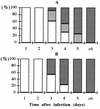Immunoglobulin A-specific capture enzyme-linked immunosorbent assay for diagnosis of dengue fever
- PMID: 9574674
- PMCID: PMC104797
- DOI: 10.1128/JCM.36.5.1189-1192.1998
Immunoglobulin A-specific capture enzyme-linked immunosorbent assay for diagnosis of dengue fever
Abstract
Dengue fever (DF) is usually diagnosed by testing for dengue virus immunoglobulin M (IgM) by a capture enzyme-linked immunosorbent assay (ELISA) (MAC-ELISA). However, IgM can last for months, and its presence might reflect a previous infection. We have tested the use of anti-dengue virus IgA capture ELISA (AAC-ELISA) for the diagnosis of DF by comparing the results of MAC-ELISAs and AAC-ELISAs for 178 serum samples taken from patients with confirmed cases of DF. IgM appears more rapidly (mean delay of positivity, 3.8 days after the onset of DF) than IgA (4.6 days) but lasts longer; the peak IgA titer is obtained on day 8. The specificity and the positive predictive value of AAC-ELISA are 100%; its sensitivity and negative predictive value (NPV) are also 100% between days 6 and 25 after the onset of DF, but they decrease drastically when data for tests conducted with specimens from the first days of infection are included, because the IgA titers, like the IgM titers, have not yet risen. AAC-ELISA is a simple method that can be performed together with MAC-ELISA and that can help in interpreting DF serology.
Figures


Similar articles
-
Comparison of PanBio dengue duo enzyme-linked immunosorbent assay (ELISA) and MRL dengue fever virus immunoglobulin M capture ELISA for diagnosis of dengue virus infections in Southeast Asia.Clin Diagn Lab Immunol. 1999 Sep;6(5):705-12. doi: 10.1128/CDLI.6.5.705-712.1999. Clin Diagn Lab Immunol. 1999. PMID: 10473522 Free PMC article.
-
[MAC-ELISA for the detection of IgM antibodies to dengue type I virus (rapid diagnosis of dengue type I virus infection)].Zhonghua Min Guo Wei Sheng Wu Ji Mian Yi Xue Za Zhi. 1989 Nov;22(4):278-85. Zhonghua Min Guo Wei Sheng Wu Ji Mian Yi Xue Za Zhi. 1989. PMID: 2700156 Chinese.
-
Comparison of IgM capture ELISA with a commercial rapid immunochromatographic card test & IgM microwell ELISA for the detection of antibodies to dengue viruses.Indian J Med Res. 2002 Feb;115:31-6. Indian J Med Res. 2002. PMID: 12138661
-
Kinetics of antibodies in sera, saliva, and urine samples from adult patients with primary or secondary dengue 3 virus infections.Int J Infect Dis. 2007 May;11(3):256-62. doi: 10.1016/j.ijid.2006.05.005. Epub 2006 Aug 17. Int J Infect Dis. 2007. PMID: 16914345
-
Dengue: a review of the laboratory tests a clinician must know to achieve a correct diagnosis.Braz J Infect Dis. 2004 Dec;8(6):390-8. doi: 10.1590/s1413-86702004000600002. Epub 2005 May 9. Braz J Infect Dis. 2004. PMID: 15880229 Review.
Cited by
-
Kinetics of dengue virus-specific serum immunoglobulin classes and subclasses correlate with clinical outcome of infection.J Clin Microbiol. 2001 Dec;39(12):4332-8. doi: 10.1128/JCM.39.12.4332-4338.2001. J Clin Microbiol. 2001. PMID: 11724841 Free PMC article.
-
Is dengue and malaria co-infection more severe than single infections? A retrospective matched-pair study in French Guiana.Malar J. 2012 May 1;11:142. doi: 10.1186/1475-2875-11-142. Malar J. 2012. PMID: 22549018 Free PMC article.
-
Immunoglobulin A antibody responses in dengue patients: a useful marker for serodiagnosis of dengue virus infection.Clin Diagn Lab Immunol. 2005 Oct;12(10):1235-7. doi: 10.1128/CDLI.12.10.1235-1237.2005. Clin Diagn Lab Immunol. 2005. PMID: 16210489 Free PMC article.
-
Detection of specific antibodies in saliva during dengue infection.J Clin Microbiol. 1998 Dec;36(12):3737-9. doi: 10.1128/JCM.36.12.3737-3739.1998. J Clin Microbiol. 1998. PMID: 9817913 Free PMC article.
-
Assessment of Industrial Antimony Exposure and Immunologic Function for Workers in Taiwan.Int J Environ Res Public Health. 2017 Jun 26;14(7):689. doi: 10.3390/ijerph14070689. Int J Environ Res Public Health. 2017. PMID: 28672853 Free PMC article.
References
-
- Boisier P, Morvan J M, Laventure S, Charrier N, Martin E, Ouledi A, Roux J. Epidémie de dengue 1 sur l’île de la Grande Comore (République Fédérale Islamique des Comores). Mars-mai 1993. Ann Soc Belge Med Trop. 1994;74:217–229. - PubMed
-
- Bundo K, Igarashi A. Antibody-capture ELISA for detection of immunoglobulin M in sera from Japanese encephalitis and dengue hemorragic fever patients. J Virol Methods. 1985;11:15–22. - PubMed
-
- Cardosa M J, Zuraini I. Comparison of an IgM capture ELISA with a dot enzyme immunoassay for laboratory diagnosis of dengue virus infections. Southeast Asian J Trop Med Public Health. 1991;22:337–340. - PubMed
-
- Chen W J, Hwang K P, Fang A H. Detection of IgM antibodies from cerebrospinal fluid and sera of dengue fever patients. Southeast Asian J Trop Med Public Health. 1991;22:659–663. - PubMed
-
- Chow L, Hsu S T. MAC-ELISA for the detection of IgM antibodies to dengue type 1 virus. Chin J Microbiol Immunol (Taiwan) 1989;22:278–285. - PubMed
MeSH terms
Substances
LinkOut - more resources
Full Text Sources
Other Literature Sources
Medical
Miscellaneous

